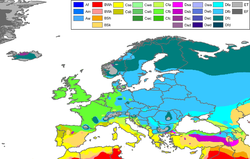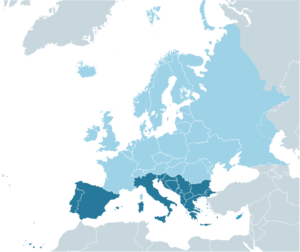
Southern Europe
Background Information
This selection is made for schools by a children's charity read more. A quick link for child sponsorship is http://www.sponsor-a-child.org.uk/
The term southern Europe, at different times, has had different meanings, providing additional political, linguistic and cultural context to the definition in addition to the typical geographical, phytogeographic or climatic approach. Most coastal countries in the United Nations-designated southern Europe border the Mediterranean Sea. Exceptions are Portugal which has only Atlantic coastline, Serbia and the Republic of Macedonia, which are landlocked, and Bulgaria, which borders the Black Sea.
Geographical definition
Geographically, southern Europe is the southern half of the landmass of Europe. This definition is relative, with no clear limits.
Countries geographically considered part of southern Europe include:
Iberian Peninsula (SW Europe)
 Andorra
Andorra Gibraltar (UK - British overseas territory)
Gibraltar (UK - British overseas territory) Portugal (including: Madeira and Azores. Madeira is sometimes considered to be northern Africa)
Portugal (including: Madeira and Azores. Madeira is sometimes considered to be northern Africa) Spain (including: Balearic Islands, Canary Islands, Ceuta, Melilla, and plazas de soberanía. The Canaries, Ceuta, Melilla and the so-called plazas de soberanía are sometimes considered to be northern Africa)
Spain (including: Balearic Islands, Canary Islands, Ceuta, Melilla, and plazas de soberanía. The Canaries, Ceuta, Melilla and the so-called plazas de soberanía are sometimes considered to be northern Africa)
Italian Peninsula
 Italy (including: Sardinia and Sicily. The South Tyrol province is sometimes considered to be central Europe)
Italy (including: Sardinia and Sicily. The South Tyrol province is sometimes considered to be central Europe) San Marino
San Marino Vatican City
Vatican City
Balkan Peninsula (SE Europe)
- Countries whose borders lie entirely within the Balkans
 Albania
Albania Bosnia and Herzegovina
Bosnia and Herzegovina Bulgaria
Bulgaria Greece (including: Aegean Islands, Crete, and Ionian Islands)
Greece (including: Aegean Islands, Crete, and Ionian Islands) Macedonia
Macedonia Montenegro
Montenegro
- Countries that are mostly located inside the Balkans
 Croatia (below Sava; the northern regions ( Slavonia, Zagreb, Međimurje and Zagorje) are sometimes considered to be central Europe)
Croatia (below Sava; the northern regions ( Slavonia, Zagreb, Međimurje and Zagorje) are sometimes considered to be central Europe) Serbia (below Sava and Danube; the northern regions ( Vojvodina, northern Belgrade and Mačva) are sometimes considered to be central Europe)
Serbia (below Sava and Danube; the northern regions ( Vojvodina, northern Belgrade and Mačva) are sometimes considered to be central Europe)
- Countries that are mostly located outside the Balkans
 Italy ( Trieste and partially Gorizia)
Italy ( Trieste and partially Gorizia) Romania ( Northern Dobruja)
Romania ( Northern Dobruja) Slovenia ( Primorska region)
Slovenia ( Primorska region) Turkey ( East Thrace region is part of the Balkans and Europe but majority of country is part of Asia)
Turkey ( East Thrace region is part of the Balkans and Europe but majority of country is part of Asia)
Island countries
 Cyprus (geographically part of Asia but considered European for historic and cultural reasons)
Cyprus (geographically part of Asia but considered European for historic and cultural reasons) Malta (including: Gozo)
Malta (including: Gozo)
United Nations geoscheme

For its official works and publications, the United Nations Organization groups countries under a classification of regions. Southern Europe, as defined by the United Nations ( the sub-regions according to the UN), comprises the following countries and territories:
 Albania
Albania Andorra
Andorra Bosnia and Herzegovina
Bosnia and Herzegovina Croatia
Croatia Gibraltar (UK - British overseas territory)
Gibraltar (UK - British overseas territory) Greece (including: Aegean Islands, Crete, and Ionian Islands)
Greece (including: Aegean Islands, Crete, and Ionian Islands) Italy (including: Sardinia and Sicily)
Italy (including: Sardinia and Sicily) Macedonia
Macedonia Malta (including: Gozo)
Malta (including: Gozo) Montenegro
Montenegro Portugal (including: Madeira and Azores)
Portugal (including: Madeira and Azores) San Marino
San Marino Serbia
Serbia Slovenia
Slovenia Spain (including: Balearic Islands, Canary Islands, Ceuta, Melilla, and plazas de soberanía)
Spain (including: Balearic Islands, Canary Islands, Ceuta, Melilla, and plazas de soberanía) Vatican City
Vatican City
As of 2009, there were 163,865,210 people living in southern Europe with an average population density of 74 inhabitants per square kilometer:
| Southern Europe: | ||||
| Country | Area (km²) |
Population (2010 est.) |
Population density (per km²) |
Capital |
|---|---|---|---|---|
| 28,748 | 2,821,977 | 111.1 | Tirana | |
| 467.63 | 84,082 | 179.8 | Andorra la Vella | |
| 51,129 | 4,613,414 | 90.2 | Sarajevo | |
| 56,594 | 4,489,409 | 81 | Zagreb | |
| 6.8 | 29,431 | 4,328 | Gibraltar | |
| 131,990 | 11,295,002 | 85.3 | Athens | |
| 301,338 | 60,418,711 | 200.5 | Rome | |
| 25,713 | 2,114,550 | 82.2 | Skopje | |
| 316 | 412,966 | 1,306.8 | Valletta | |
| 13,812 | 672,181 | 50 | Podgorica | |
| 92,090 | 11,317,192 | 114 | Lisbon | |
| 61.2 | 31,716 | 501 | City of San Marino | |
| 88,361 | 7,120,666 | 102.46 | Belgrade | |
| 20,273 | 2,054,199 | 99.6 | Ljubljana | |
| 504,030 | 46,030,109 | 93 | Madrid | |
| 0.44 | 826 | 1877 | Vatican City | |
| Total | 1,338,694 | 163,865,210 | 74.05 | |
Climatical definition

Southern Europe's most emblematic climate is that of the Mediterranean climate, which has become a typically known characteristic of the area.
Those areas of Mediterranean climate present similar vegetations and landscapes throughout, including dry hills, small plains, pine forests and olive trees.
The area which is considered climatically southern Europe is:
 Albania
Albania Bosnia and Herzegovina (coasts)
Bosnia and Herzegovina (coasts) Bulgaria (southern coast and extreme southwest)
Bulgaria (southern coast and extreme southwest) Croatia (coasts)
Croatia (coasts) Cyprus
Cyprus France (southeast coast, and the island of Corsica)
France (southeast coast, and the island of Corsica) Gibraltar
Gibraltar Greece
Greece Italy (except the Po River plain and Alps region)
Italy (except the Po River plain and Alps region) Macedonia (extreme south)
Macedonia (extreme south) Malta
Malta Monaco
Monaco Montenegro (coasts)
Montenegro (coasts) Portugal
Portugal Slovenia (coasts)
Slovenia (coasts) Spain (the whole of the country except the northern coast and the Pyreenes)
Spain (the whole of the country except the northern coast and the Pyreenes)
Phytogeographical definition
Southern Europe's flora is that of the Mediterranean Region, one of the phytochoria recognized by Armen Takhtajan. The Mediterranean and Submediterranean climate regions in Europe comprise the following countries and territories:
 Albania
Albania Bosnia and Herzegovina
Bosnia and Herzegovina Bulgaria
Bulgaria Croatia
Croatia Cyprus
Cyprus France (the southern and southeastern part, and the island of Corsica)
France (the southern and southeastern part, and the island of Corsica) Greece (including: Aegean Islands, Crete, and Ionian Islands)
Greece (including: Aegean Islands, Crete, and Ionian Islands) Hungary (the southwestern part till the Lake Balaton)
Hungary (the southwestern part till the Lake Balaton) Italy
Italy Macedonia
Macedonia Malta
Malta Montenegro
Montenegro Portugal (except for the northwestern part)
Portugal (except for the northwestern part) Romania (only the southern part along the Danube river)
Romania (only the southern part along the Danube river) Serbia
Serbia Slovenia
Slovenia Spain (except for the northwestern part)
Spain (except for the northwestern part) Switzerland (only Ticino)
Switzerland (only Ticino) Ukraine (only the southern part of Crimea)
Ukraine (only the southern part of Crimea)
Linguistic southern Europe
Romance languages and modern Greek are the heirs of Latin and ancient Greek as the main historical languages of the Mediterranean area.
Romance languages
Romance languages have spread from the Italian peninsula, and are emblematic of southern-western Europe: the " Latin Arch" (Romania and Moldova are an exception on that point). Note that, Romance-speaking countries like Belgium (Wallonia), France, Monaco, Moldova, Romania, and Switzerland (French, Italian and Romansh speaking areas) do not belong to Southern Europe:
 Andorra: Catalan (also French, Portuguese, Spanish)
Andorra: Catalan (also French, Portuguese, Spanish) Belgium* ( Wallonia): French (also Walloon)
Belgium* ( Wallonia): French (also Walloon) France*: French (also Occitan, Oïl languages, Franco-Provençal, Catalan, Corsican)
France*: French (also Occitan, Oïl languages, Franco-Provençal, Catalan, Corsican) Italy: Italian, Friulian, Ladin, Sardinian, plus other regional languages, not officially recognised by Italian Republic ( Piedmontese, Ligurian, Lombard, Venetian, Emiliano and Romagnolo, Neapolitan, Sicilian)
Italy: Italian, Friulian, Ladin, Sardinian, plus other regional languages, not officially recognised by Italian Republic ( Piedmontese, Ligurian, Lombard, Venetian, Emiliano and Romagnolo, Neapolitan, Sicilian) Moldova*: Romanian (Moldovan)
Moldova*: Romanian (Moldovan) Monaco*: French (also Monégasque, Occitan, Italian)
Monaco*: French (also Monégasque, Occitan, Italian) Portugal: Portuguese, Mirandese
Portugal: Portuguese, Mirandese Romania*: Romanian
Romania*: Romanian San Marino: Italian
San Marino: Italian Spain: Spanish, Catalan/Valencian, Galician (plus Aragonese, Asturian, Leonese, Extremaduran, Occitan)
Spain: Spanish, Catalan/Valencian, Galician (plus Aragonese, Asturian, Leonese, Extremaduran, Occitan) Switzerland*: French, Italian, Romansh
Switzerland*: French, Italian, Romansh Vatican City: Italian
Vatican City: Italian
- Small communities in
 Albania: Aromanian (officially, Albanian, see below)
Albania: Aromanian (officially, Albanian, see below) Bosnia and Herzegovina: Ladino (officially, Bosnian, Croatian and Serbian, see below)
Bosnia and Herzegovina: Ladino (officially, Bosnian, Croatian and Serbian, see below) Bulgaria: Aromanian, Ladino (officially, Bulgarian, see below)
Bulgaria: Aromanian, Ladino (officially, Bulgarian, see below) Gibraltar: Llanito, Spanish (officially, English, see below)
Gibraltar: Llanito, Spanish (officially, English, see below) Greece: Aromanian, Ladino (officially, Greek, see below)
Greece: Aromanian, Ladino (officially, Greek, see below) Macedonia: Aromanian, Ladino (officially, Macedonian, see below)
Macedonia: Aromanian, Ladino (officially, Macedonian, see below) Malta: Sicilian, Italian (officially, English and Maltese, see below)
Malta: Sicilian, Italian (officially, English and Maltese, see below) Serbia: Aromanian, Ladino (officially, Serbian, see below)
Serbia: Aromanian, Ladino (officially, Serbian, see below)
Greek language
- Small communities in
Albanian language
 Albania
Albania Kosovo*
Kosovo*
Albanian is also a language rooted in southern Europe, spoken in the Balkan peninsula.
Gheg:
Tosk:
 Southern Albania
Southern Albania West Macedonia
West Macedonia Chameria, Greece
Chameria, Greece Italy: Arbëresh (spoken by small communities in Apulia, Basilicata, Calabria, Campania, Molise, and Sicily)
Italy: Arbëresh (spoken by small communities in Apulia, Basilicata, Calabria, Campania, Molise, and Sicily)
South Slavic languages
Slavic languages that are now spoken in southern Europe are not rooted in the Mediterranean area nor spoken mainly in those areas: In that sense those languages are not part of the linguistic definition of southern Europe, since they are logically associated with their "core". That said, southern Slavic languages form a quite homogenous area, geographically separated from north Slavic languages by Hungary and Romania.
 Bosnia and Herzegovina: Bosnian, Croatian, Serbian
Bosnia and Herzegovina: Bosnian, Croatian, Serbian Bulgaria: Bulgarian
Bulgaria: Bulgarian Croatia: Croatian, Serbian
Croatia: Croatian, Serbian Macedonia: Macedonian
Macedonia: Macedonian Montenegro: Montenegrin, Serbian
Montenegro: Montenegrin, Serbian Serbia: Serbian
Serbia: Serbian Slovenia: Slovene
Slovenia: Slovene
- Small communities in
 Italy: Slovene (in Eastern Friuli-Venezia Giulia)
Italy: Slovene (in Eastern Friuli-Venezia Giulia)
Germanic languages
Due to the English colonisation in Malta and Gibraltar, Germanic languages have a little presence in southern Europe, far from the core of Germanic languages in northwestern Europe. Malta uses English as a second language in some cases (after Maltese, which still is the original and main native language). In Gibraltar, English is the official language but Spanish and Llanito (mix of Andalusian Spanish with some English) are also spoken.
- Small communities in
Maltese language
 Malta: Maltese
Malta: Maltese
Basque language
The Basque language is a linguistic isolate spoken by the Basque people, who inhabit the Basque Country, a region spanning an area in northeastern Spain and southwestern France.


